Scottish Cancer Patient Experience Survey 2015/16
Results from the 2015/16 Scottish Cancer Patient Experience Survey. The survey covers the full care journey that a cancer patient experiences, from thinking that something might be wrong with them to the support they received after their acute-care treatm
Overall NHS Care
The survey asks about the coordination of the patients' care across all health professionals, the administration of records and appointments, and the wait times at various clinical appointments. These all contribute to how patients experience the quality of their care.
It is also important for patients to know that should they want to participate in cancer research, they have the opportunity to do so.
Finally, a care plan is a document that sets out the patients' needs and goals for caring for their cancer. It is an agreement or plan between the patient and their health professional to help meet those goals.
Different practitioners working together
Eighty-nine per cent of patients considered that the different people treating them had worked well together to give them the best possible care 'always' or 'most of the time' (Table 48).
Table 48: Different practitioners working well together
| Did the different people treating and caring for you (such as GP, hospital doctors, hospital nurses, specialist nurses, community nurses) work well together to give you the best possible care? |
n |
% |
|---|---|---|
| Yes, always |
2,867 |
63% |
| Yes, most of the time |
1,190 |
26% |
| Yes, some of the time |
373 |
8% |
| No, never |
111 |
2% |
| Total |
4,541 |
100% |
There was some variation in responses from different tumour groups. However, statistical tests concluded that these differences as a whole were not statistically significant.
Cancer research
Patients were asked whether anyone had discussed taking part in cancer research with them. Only 22 per cent of patients reported that they had discussed this. However, of the patients who had not been involved in a discussion regarding research, only a minority would have liked to have been (Table 49).
Table 49: Discussion about taking part in cancer research
| Since your diagnosis, has anyone discussed with you whether you would like to take part in cancer research? |
n |
% |
|---|---|---|
| Yes |
1,007 |
22% |
| No |
3,280 |
73% |
| No, but I would have liked them to |
198 |
4% |
| Total |
4,485 |
100% |
Patients with colorectal / lower gastrointestinal (30%) and breast (27%) tumours were statistically more likely to have had a discussion regarding taking part in research than the all-cancer average. Tumour groups that were statistically below average included skin (12%) and gynaecological (13%) (Figure 38).
Figure 38: % receiving discussion about taking part in cancer research, by tumour group
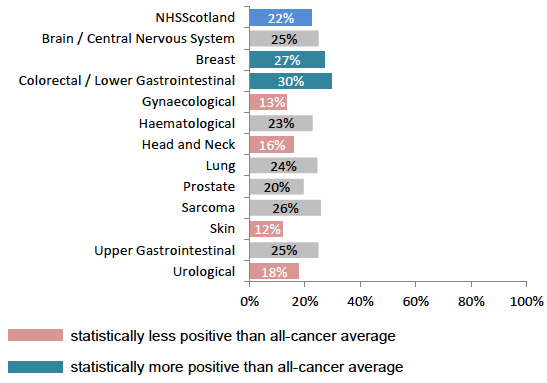
Administration of care
Patients were generally positive about the administration of their care. Ninety per cent rated the administration as either 'very good' or 'good'. Three per cent of patients described it as 'quite bad' or 'very bad' (Table 50).
Table 50: Administration of care
| Overall, how would you rate the administration of your care (getting letters at the right time, doctors having the right notes/tests results, etc)? |
n |
% |
|---|---|---|
| Very good |
2,832 |
60% |
| Good |
1,368 |
29% |
| Neither good nor bad |
328 |
7% |
| Quite bad |
111 |
2% |
| Very bad |
51 |
1% |
| Total |
4,690 |
100% |
Statistical differences from the all-cancer average included haematological tumour patients, who were above average with 94 per cent responding 'very good' or 'good' (Figure 39).
Figure 39: % rating administration of care as 'very good' or 'good', by tumour type
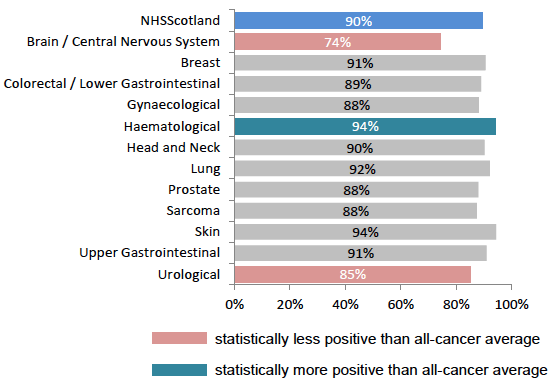
Waits when attending clinics and appointments
Overall, around a quarter of patients described the length of time they had to wait when attending clinics and appointments as either 'much too long' (6%) or 'a little too long' (19%) (Table 51).
Table 51: Waits at clinics and appointments
| Overall, how do you feel about the length of time you had to wait when attending clinics and appointments for your cancer treatment? |
n |
% |
|---|---|---|
| Much too long |
258 |
6% |
| A little too long |
866 |
19% |
| About right |
3,521 |
76% |
| Total |
4,645 |
100% |
Patients with breast tumours (73%) were statistically less likely than the all-cancer average to describe their waits for clinics and appointments as 'about right' (73%). Patients with colorectal / lower gastrointestinal (80%) and gynaecological tumours (81%) were both statistically more likely than average (Figure 40).
Figure 40: % reporting waits at clinics and appointments as 'about right', by tumour group
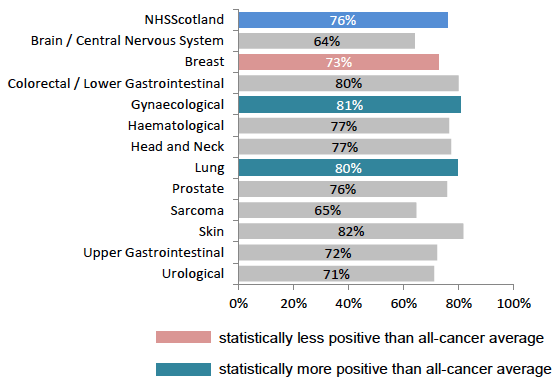
Care plan
Patients were asked whether they had been given a care plan. Only twenty-two per cent of patients confirmed that they had been given a care plan. The other patients responded that they either did not have one (66%) or did not know what a care plan was (12%), which is strongly suggestive that they did not have one (Table 52).
Table 52: Care plan
| Have you been given a care plan? |
n |
% |
|---|---|---|
| Yes |
913 |
22% |
| No |
2,759 |
66% |
| I do not know / understand what a care plan is |
496 |
12% |
| Total |
4,168 |
100% |
The only tumour groups which were statistically different from the all-cancer average were gynaecological and urological tumours, which were both below average at 17 per cent (Table 41).
Figure 41: % given care plan, by tumour group
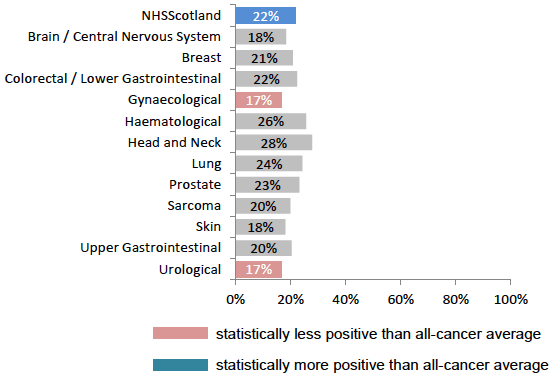
Fifty of the questions in the survey had response options that could be categorised as either positive or negative ( Annex C). For each of these questions, the percentage of patients with a care plan responding positively was compared to the percentage of patients responding positively who did not have a care plan, or did not know what one was.
For every single question, patients who had a care plan responded statistically more positively. This included the overall rating of care (98% positive response amongst those with a care plan vs 92% positive response amongst those without a care plan) and large differences for questions such as receiving enough care and support from health or social services after treatment (73% vs 34%) and receiving information about how to get financial help and benefits (75% vs 42%).
Overall rating of care
At the conclusion of the survey, patients were asked to provide an overall rating of the cancer care they had received. The scale ranged from 0 ('very poor') to 10 ('very good'). Responses were highly positive with 94 per cent of patients selecting a rating between seven and ten. One per cent of patients gave a negative rating (0-3) (Table 53, Figure 42).
Figure 42: Breakdown of overall rating of care
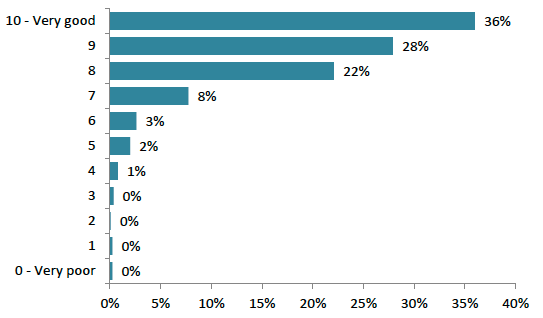
Table 53: Overall rating of care
| Overall, how would you rate your care (scale from 0 to 10)? |
n |
% |
|---|---|---|
| Positive (7-10) |
4,320 |
94% |
| Neutral (4-6) |
248 |
5% |
| Negative (0-3) |
41 |
1% |
| Total |
4,609 |
100% |
There was some variation in responses from different tumour groups. However, statistical tests concluded that these differences as a whole were not statistically significant.
Contact
There is a problem
Thanks for your feedback